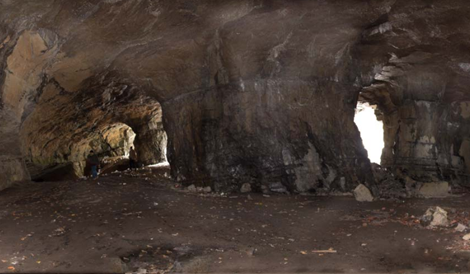This is, I must confess, the weirdest place from which I have ever broadcast, says a woman’s voice on a scratchy recording of a 1950’s NBC radio show. That weird place is a cave in New York State, and the voice belongs to a reporter on one of the late Mike Wallace’s radio talk shows in 1956.
“These caves are perfectly enormous, and all around me, as far as I can see, there are boxes … of mushrooms,” she continues. The reporter was inside one of nine depleted limestone mines that belonged to Knaust Brothers, at the time the biggest mushroom supplier in the US. The dark, humid caves provided perfect conditions for growing mushrooms.
The Kingston Mine in Kingston, from where the NBC reporter was broadcasting, now belongs to the grandchildren of Herman Knaust, founder of the mushroom company. They are pitching it as a place to build a data center. Some of the attributes they say make it fit for that use are the huge amount of useable space, a naturally cool environment, a free-cooling system that uses water from a subterranean lake devised in its mushroom-growing days, access to about 10MW of power and the fact that it is 100ft below ground – a physical-security feature so beloved by evil doctors, from Dr No to Dr Evil.
The mine is on the eastern side of Kingston and less than one mile from the Hudson River. Part of its 250,000 sq ft of space is below a city park. Mark Knaust, one of the three siblings who inherited the cavern, says it has been sitting unused since the mid-1960s. The owners are not yet certain how it will be used. “We’ve always thought it could be a site for growing specialty-type mushrooms,” Knaust says. Another idea was food storage. A data center, however, would be a more dynamic use and would require higher-level investment.
Knaust believes the cooling system, designed by his grandfather and local engineer Paul Sturges, will translate well for data center use. It uses thermal capacity of the surrounding rock and water from the cave’s own aquifer as a heat-transfer medium to cool the space.
The system’s air-conditioning capacity was 190 tons, according to an article written by Sturges and published by Power Magazine in 1957. Consisting of two-stage air washer and water coils, it used the underground lake’s surface water in the winter and lower-level water in the summer. The only electricity it consumed was used by two three-horse-power water pumps.
The nuclear-scare market
This was when Knaust Brothers was in its heyday, growing about 15m pounds of mushrooms across all its locations. Herman Knaust, Mark Knaust’s father and son of Herman Knaust who started the company, says his father had a keen interest in mycology. He hired scientists who helped Knaust Brothers become a major producer of streptomycin in the 1940s for Merck & Co, which supplied the antibiotic to US armed forces during WWII.
In the 1950s, Herman Knaust found another use for his underground empire: document storage. The mushroom market was changing: there was the Cold War nuclear threat, but he had also been sponsoring the immigration of European Jews displaced by the war to the US. Many had lost every trace of their previous existence. “There was no record of them having been born or having lived,” Mark Knaust says.
Nuclear anxiety was very much in the air, and his grandfather saw a need for a safe place to store documents by people, companies and the government. So he opened a document storage business he called Iron Mountain Atomic Storage, using one of his former mushroom mines in Livingston. Soon enough, the business was booming, with all major corporations – from banks to movie studios – hiding their valued records in the Iron Mountain.
By the 1970s, the company went bankrupt and was sold to a private investor. Today, Iron Mountain is a publicly traded corporation with 20,000 employees around the world and US$3bn in annual revenue. It still provides record storage, but has added record management and destruction services and data backup and recovery. Perhaps not coincidentally, it has built a data center in one of its underground storage facilities in Boyers, Pennsylvania.
The Knausts no longer have ties to Iron Mountain. Mark Knaust and his brother have a contracting firm – Knaust Brothers – and their sister Barbara Hancock runs a communications contractor serving corporations in Japan. While they are marketing their cavern for multiple uses, data center use is central in their efforts. As the narrator in a short documentary film about the cave says: “From its vast rechargeable aquifers, massive useable space and constant temperature, the Kingston cave is poised to meet the needs of the 21st century.”
DatacenterDynamics Converged New York is on tomorrow at the Marriott Marquis. Keynote speakers include retired US colonel Jack Jacobs, L&L Holding’s managing director Ron Shindel and VMware CTOs for end-user computing Paul Strong and Scott Davis, among others. To find out more, visit the website here. To hear more from the event, make sure you are signed up to tomorrow’s FOCUS newsletter and our online magazine, where coverage will be provided from the event.

